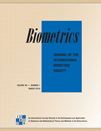A Likelihood-Based Trait-Model-Free Approach for Linkage Detection of Binary Trait
Abstract
Summary Trait-model-free (or “allele-sharing”) approach to linkage analysis is a popular tool in genetic mapping of complex traits, because of the absence of explicit assumptions about the underlying mode of inheritance of the trait. The likelihood framework introduced by Kong and Cox (1997, American Journal of Human Genetics 61, 1179–1188) allows calculation of accurate p-values and LOD scores to test for linkage between a genomic region and a trait. Their method relies on the specification of a model for the trait-dependent segregation of marker alleles at a genomic region linked to the trait. Here we propose a new such model that is motivated by the desire to extract as much information as possible from extended pedigrees containing data from individuals related over several generations. However, our model is also applicable to smaller pedigrees, and has some attractive features compared with existing models (Kong and Cox, 1997), including the fact that it incorporates information on both affected and unaffected individuals. We illustrate the proposed model on simulated and real data, and compare its performance with the existing approach (Kong and Cox, 1997). The proposed approach is implemented in the program lm_ibdtests within the framework of MORGAN 2.8 (http://www.stat.washington.edu/thompson/Genepi/MORGAN/Morgan.shtml).




